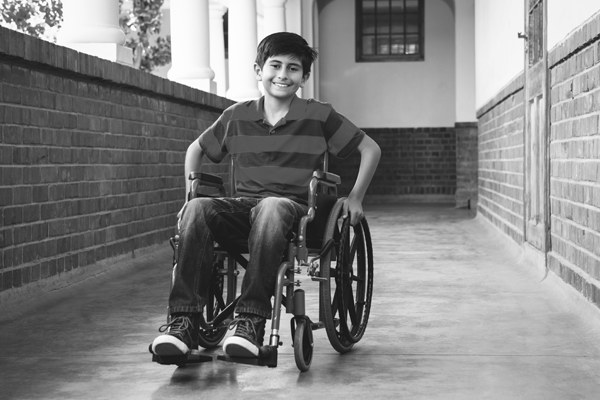Neurorehabilitation for Children With Batten Disease
Neurorehabilitation for Children With Batten Disease https://pediatricsnationwide.org/wp-content/uploads/2021/01/082614ds317-2-1024x683.jpg 1024 683 Lauren Dembeck Lauren Dembeck https://pediatricsnationwide.org/wp-content/uploads/2021/03/Dembeck_headshot.gif- February 27, 2024
- Lauren Dembeck

Therapy should be tailored to each child’s needs.
Batten disease comprises a rare group of related genetic disorders characterized by progressive neurodegeneration. The disease primarily presents in childhood as seizures, vision loss, and developmental regression. Neurorehabilitation services, including physical therapy (PT), occupational therapy (OT), and speech-language pathology therapy (SLP), can delay loss of function and impairment and improve quality of life for these children and their families. However, given the rarity of Batten disease, standardized clinical recommendations and outcome assessments for neurorehabilitation have not yet been established.
“Historically, children with Batten disease would have a shortened lifespan. However, now, with the advent of novel treatments, patients are living longer and need differing levels of neurorehabilitation support,” says Emily de los Reyes, MD, attending pediatric neurologist and director of the Nationwide Children’s Hospital Batten Disease Center of Excellence.
In a study published in Pediatric Neurology, Dr. de los Reyes and colleagues describe the developmental profiles, current dose of neurorehabilitation, and outcome assessments used at Nationwide Children’s for children diagnosed with Batten disease.
“We have needed outcome assessment tools developed specifically for this population to capture changes in their developmental trajectory, to guide clinical recommendations, and for use in clinical trials,” adds first author of the study Rachel Bican, PT, DPT, PhD, assistant professor and principal investigator of the Pediatric FUNctional Mobility (FUN) Lab at Ohio University. “The findings from this study have served as a basis for developing those tools within the Batten Clinic at Nationwide Children’s.”
The multidisciplinary research team, which included a dedicated physician, occupational therapist, physical therapist, and speech-language pathologist, reviewed electronic medical records of 70 children with the most common subtypes of Batten disease (subtypes: CLN1, n = 5; CLN2, n = 25; CLN3, n = 23; CLN6, n = 17). On average, patients were 7 years of age.
The team investigated the occurrence of clinical features that may impact neurorehabilitation that were present in children with Batten disease. Overall, the most common clinical features were vision impairments (61%) and seizures (68%). Most children experienced delays in fine motor (65%), gross motor (80%), cognitive (63%), and language skills (83%).
Children typically received neurorehabilitation services through early education/school, outpatient clinic, or a combination of these settings. However, to the surprise of the researchers, 20% of children did not receive any PT or OT services, and 25% of children did not receive SLP services.
Neurorehabilitation was most frequently administered weekly (42% for OT and 43% for PT and SLP). Developmental outcomes were tracked with two standardized outcome assessments, the Peabody Developmental Motor Scales, second edition (30%) and the Preschool Language Scales, fifth edition (27.4%).
“Given that the Nationwide Children’s Batten Disease Center of Excellence sees so many patients with this incredibly rare disease, we thought this would be a great opportunity to provide a framework for neurorehabilitation and to share information with other neurorehabilitation specialists who will typically see very few, if any, patients with Batten disease in their entire career,” says Dr. Bican.
The study underscores the need for continued development and validation of new outcome measures for children with Batten disease.
“Each child has different needs at different points in time, and regression occurs at different times. Thus, the therapists need to be able to tailor neurorehabilitation to the needs of each child,” says Dr. de los Reyes, who is also a professor of Clinical Pediatrics and Neurology at The Ohio State University College of Medicine. “Although this is a progressive disease, a lot can still be done for each child. The therapists together with the family have to make the decisions about how to personalize therapy to each child’s needs.”
Reference
Bican R, Goddard V, Abreu N, Peifer D, Basinger A, Sveda M, Tanner K, de Los Reyes EC. Developmental Skills and Neurorehabilitation for Children With Batten Disease: A Retrospective Chart Review of a Comprehensive Batten Clinic. Pediatr Neurol. 2024 Mar;152:107-114. doi: 10.1016/j.pediatrneurol.2023.12.001. Epub 2023 Dec 5. PMID: 38242022.
About the author
Lauren Dembeck, PhD, is a freelance science and medical writer based in New York City. She completed her BS in biology and BA in foreign languages at West Virginia University. Dr. Dembeck studied the genetic basis of natural variation in complex traits for her doctorate in genetics at North Carolina State University. She then conducted postdoctoral research on the formation and regulation of neuronal circuits at the Okinawa Institute of Science and Technology in Japan.
-
Lauren Dembeckhttps://pediatricsnationwide.org/author/lauren-dembeck/
-
Lauren Dembeckhttps://pediatricsnationwide.org/author/lauren-dembeck/
-
Lauren Dembeckhttps://pediatricsnationwide.org/author/lauren-dembeck/
-
Lauren Dembeckhttps://pediatricsnationwide.org/author/lauren-dembeck/January 29, 2019
- Posted In:
- Clinical Updates
- In Brief
- Research







